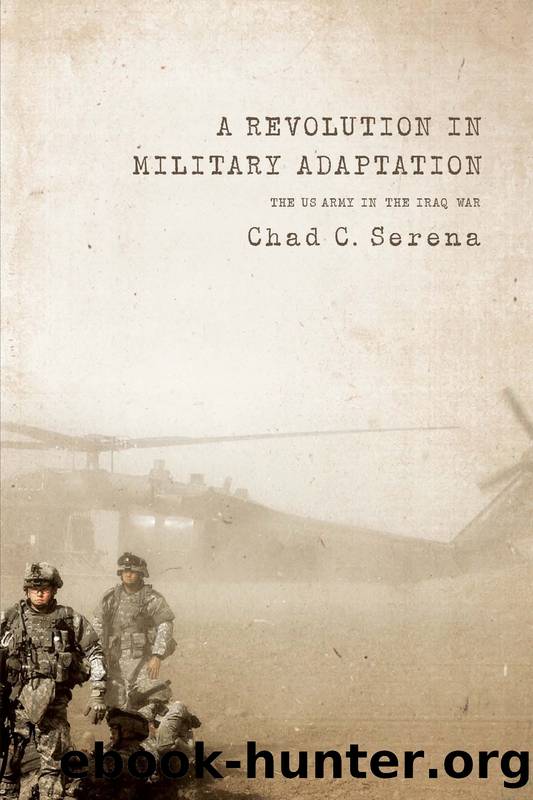A Revolution in Military Adaptation: The US Army in the Iraq War by Chad C. Serena

Author:Chad C. Serena [Serena, Chad C.]
Language: eng
Format: epub
Tags: Iraq War (2003-2011), Strategy, Military, Political Science, History, Security (National & International), General
ISBN: 9781589017832
Google: WE7gab2ztDQC
Goodreads: 13013929
Publisher: Georgetown University Press
Published: 2011-09-01T00:00:00+00:00
Conclusion
Many of the armyâs organizational inputs proved to be impediments to adaptation. The goals and rewards system, designed for combat operations, was slow to change and still does not formally recognize the realities of current conflicts. The preponderance of the armyâs core tasks is still combat-centric. An intelligence architecture designed for state-based enemies but applied in nonstandard operational environments against unconventional adversaries leads to collection, analysis, and dissemination problems that were worsened by standardized doctrine, training, and education. War-fighting norms are particularly resistant to change by the nature of the institution and its principal historical duty. The armyâs acquisition system is still generally slow, but changes to fielding initiatives have reduced the time required to acquire systems and equipment as the need arises. Equipment, designed primarily if not solely for MCO, was perhapsâand not surprisinglyâthe slowest input to change and had direct and indirect deleterious effects on almost all of the other organizational inputs examined in this chapter.
But some of the armyâs organizational inputs expanded unit-level adaptation. Robust and diverse communications networks allowed for the decentralized flow of ideas and experiences. Training was adjusted to reflect the necessities of operations, even if the training regimen and format still assumes a relatively static and doctrinal operational environment and enemy. Relaxed constraints allowed for the decentralization of decision making and expanded the adaptive freedom of junior leaders as they were exposed to the operational environment. Readily available general funds allowed units to adapt to circumstances not planned for in initial budgets. And efforts to engage in consultation with local actors and expanded cooperation with external personnel and local forces expanded unitsâ capacity for understanding the operational environment and conducting missions.
Understanding how these organizational inputs were modified as the army adapted is critical to grasping what needed and needs to be changed to achieve organizational and institutional success in OIF and in future operational environments. Adaptations made (and those not made) are indicators not only of what the army needs to change to effectively match capability with requirements but also what it should capture to enable organizational adaptability in the future. None of these organizational inputs can be examined in isolation from one another if the organizationâs capacity for and method of adaptation is to be examined appropriately. Likewise, organizational inputs, although a critical element, are only one-third of the adaptive cycle. Organizational inputs and adaptations to organizational inputs are linked to and affect the two other elements of the adaptive cycle: organizational outputs and organizational learning. Each will be examined in detail in the following chapter.
Download
This site does not store any files on its server. We only index and link to content provided by other sites. Please contact the content providers to delete copyright contents if any and email us, we'll remove relevant links or contents immediately.
| Civil War | Operation Desert Storm |
| Veterans | Vietnam War |
The Radium Girls by Kate Moore(11930)
100 Deadly Skills by Clint Emerson(4843)
Rise and Kill First by Ronen Bergman(4705)
The Templars by Dan Jones(4629)
The Doomsday Machine by Daniel Ellsberg(4420)
The Rape of Nanking by Iris Chang(4139)
Killing England by Bill O'Reilly(3953)
Hitler in Los Angeles by Steven J. Ross(3901)
Stalin by Stephen Kotkin(3880)
12 Strong by Doug Stanton(3510)
Hitler's Monsters by Eric Kurlander(3269)
Blood and Sand by Alex Von Tunzelmann(3140)
The Code Book by Simon Singh(3077)
Darkest Hour by Anthony McCarten(3072)
The Art of War Visualized by Jessica Hagy(2945)
Hitler's Flying Saucers: A Guide to German Flying Discs of the Second World War by Stevens Henry(2716)
Babylon's Ark by Lawrence Anthony(2622)
The Second World Wars by Victor Davis Hanson(2485)
Tobruk by Peter Fitzsimons(2446)
